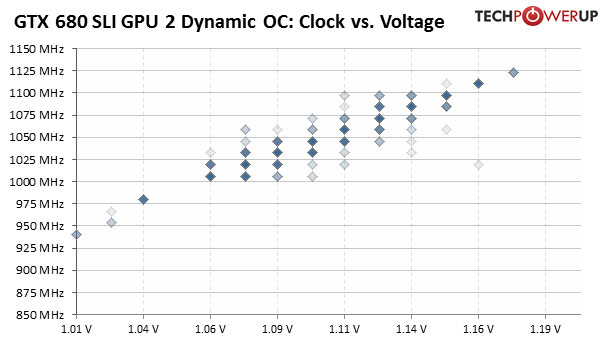 175
175
NVIDIA GeForce GTX 690 4 GB Review
Value & Conclusion »Temperatures

Temperatures are looking good and are in a perfectly safe range.
NVIDIA's dynamic overclocking mechanism takes temperature into account and lowers maximum boost clocks by 13 MHz each 10°C, so there would be an extra 13 MHz if the card ran 1.5°C cooler.
| GPU Temperature Comparison | ||
|---|---|---|
| Idle | Load | |
| NVIDIA GTX 690 | 35°C | 81°C |
| Palit GTX 680 JetStream | 33°C | 78°C |
| AMD HD 7970 | 45°C | 78°C |
| NVIDIA GTX 680 | 45°C | 85°C |
| ASUS GTX 680 DirectCU II | 33°C | 70°C |
| AMD HD 7970 | 45°C | 78°C |
cooler design and production variances. This table just serves to provide
a list of typical temperatures for similar cards, reached during TPU review.
Clock Profiles
Modern graphics cards have several clock profiles that are selected to balance power draw and performance requirements.The following table lists the clock settings for important performance scenarios and the GPU voltage that we measured. We measure on the pins of a coil or capacitor near the GPU voltage regulator.
| Core Clock | Memory Clock | GPU Voltage (measured) | |
|---|---|---|---|
| Desktop | 324 MHz 324 MHz | 162 MHz | 0.98 V 0.98 V |
| Multi-Monitor | 324 MHz 324 MHz | 162 MHz | 0.98 V 0.98 V |
| Blu-ray Playback | 324 MHz 324 MHz | 162 MHz | 0.98 V 0.98 V |
| 3D Load | 902-1071 MHz 888-1071 MHz | 1575 MHz 1575 MHz | 1.037-1.175 V 1.025-1.175 V |
The card uses NVIDIA's dynamic overclocking mechanism, which means it will dynamically adjust clock and voltage based on render load, temperature and other factors.
For the graphs below, we recorded all GPU clock, GPU voltage combinations of our benchmarking suite for the 1920x1200 resolution. The plotted points have transparency, so they can add up to indicate more often used values. A light color means the clock/voltage combination is rarely used, a dark color means it's active a lot.


We can see that both GPUs run different clocks, with the first one being typically higher clock and voltage while the second one uses more balanced clocks and voltages.


I ran the same tests on a dual card GTX 680 SLI configuration for your reference.
Jul 14th, 2025 19:00 CDT
change timezone
Latest GPU Drivers
New Forum Posts
- No offense, here are some things that bother me about your understanding of fans. (118)
- AMD 7Ghz? This keeps popping up on my feeds! (22)
- Cryptocoin Value and Market Trend Discussion (1657)
- System stutters with Ryzen 7 9800X3D. (1)
- Dual GPU Motherboard for home VFX (1)
- i7 2860QM how to raise power limit? (24)
- Large Format Plotter WiFi / LAN issue on Laptop (2)
- Is there a WIFI chip I should get? (3)
- How about AMD instead of Intel? (40)
- AI Job Losses: let's count the losses up, total losses to AI so far 94,000 and counting (7)
Popular Reviews
- Lexar NM1090 Pro 4 TB Review
- MSI GeForce RTX 5060 Gaming OC Review
- Our Visit to the Hunter Super Computer
- Fractal Design Epoch RGB TG Review
- NVIDIA GeForce RTX 5050 8 GB Review
- Corsair FRAME 5000D RS Review
- Sapphire Radeon RX 9060 XT Pulse OC 16 GB Review - An Excellent Choice
- Chieftec Iceberg 360 Review
- AMD Ryzen 7 9800X3D Review - The Best Gaming Processor
- Upcoming Hardware Launches 2025 (Updated May 2025)
TPU on YouTube
Controversial News Posts
- Intel's Core Ultra 7 265K and 265KF CPUs Dip Below $250 (288)
- Some Intel Nova Lake CPUs Rumored to Challenge AMD's 3D V-Cache in Desktop Gaming (140)
- AMD Radeon RX 9070 XT Gains 9% Performance at 1440p with Latest Driver, Beats RTX 5070 Ti (131)
- NVIDIA Launches GeForce RTX 5050 for Desktops and Laptops, Starts at $249 (122)
- NVIDIA GeForce RTX 5080 SUPER Could Feature 24 GB Memory, Increased Power Limits (115)
- Microsoft Partners with AMD for Next-gen Xbox Hardware (105)
- Intel "Nova Lake‑S" Series: Seven SKUs, Up to 52 Cores and 150 W TDP (100)
- NVIDIA DLSS Transformer Cuts VRAM Usage by 20% (97)